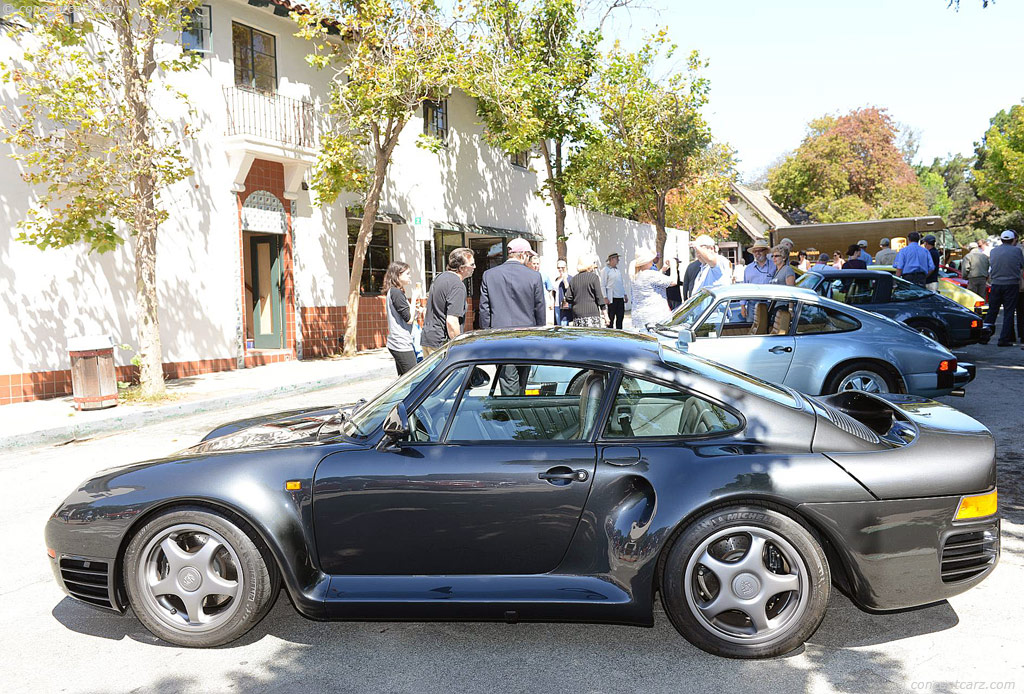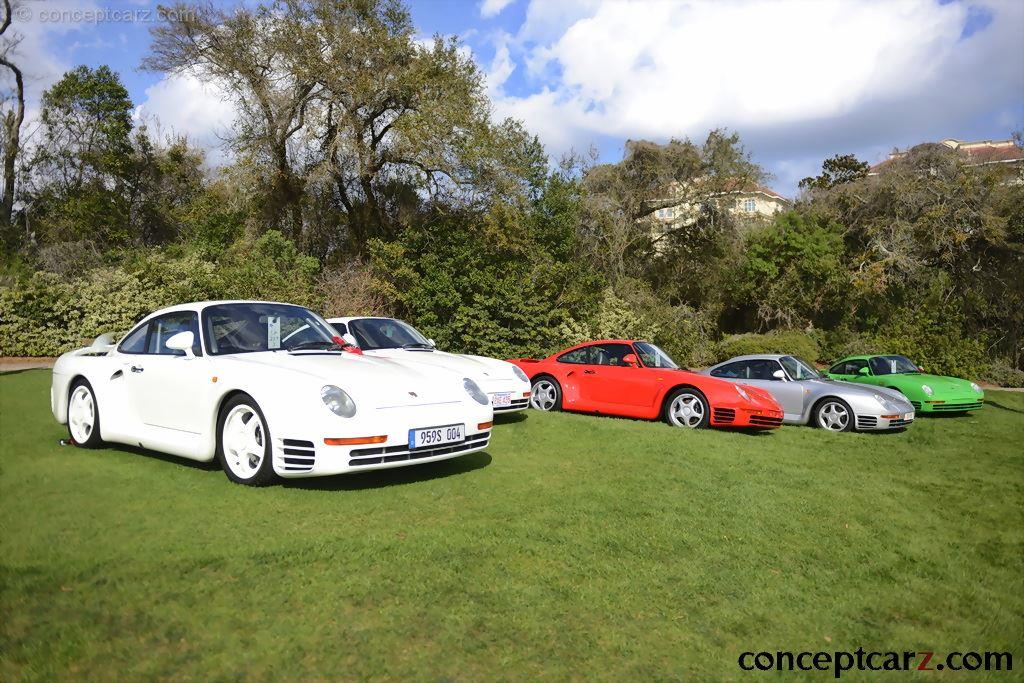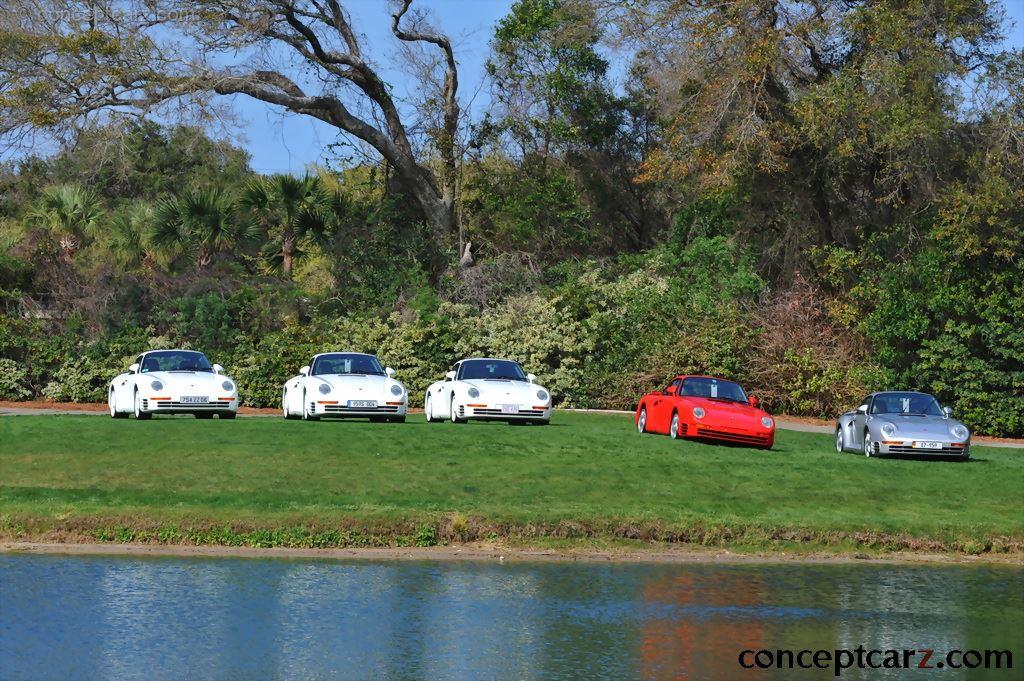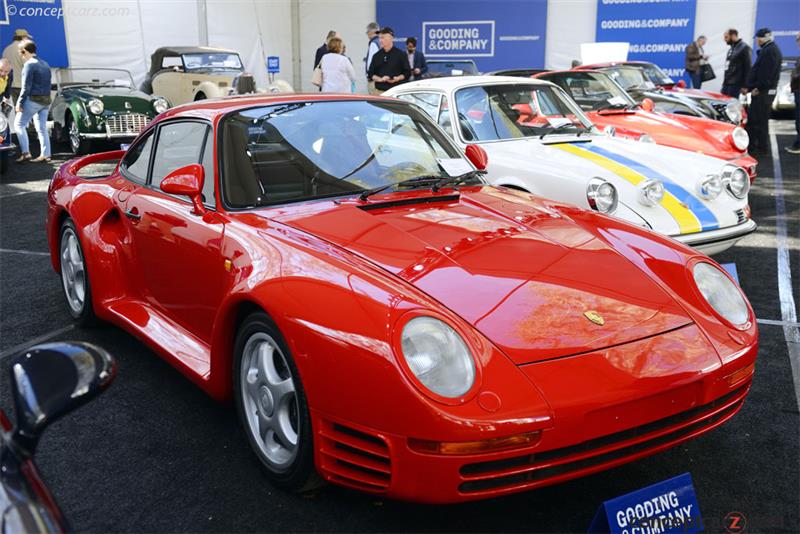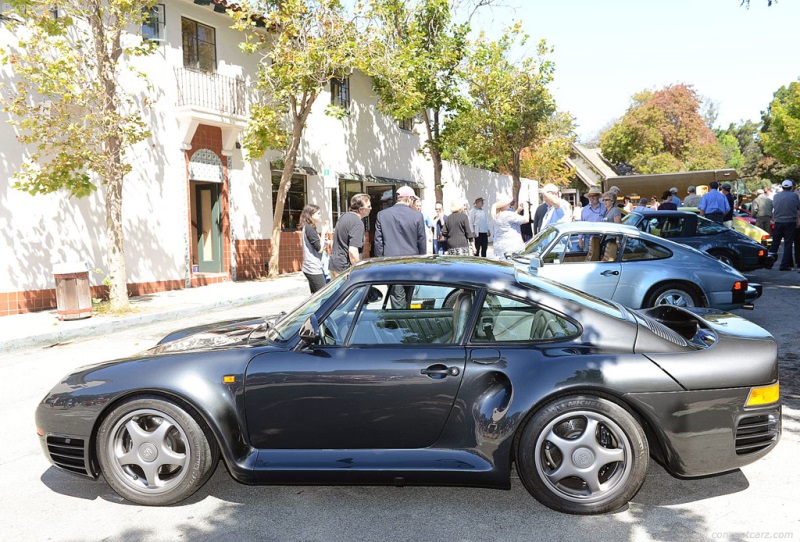The Porsche 959 was the result of extensive development and its unparalleled levels of performance were courtesy of cutting-edge technologies. Numerous features were introduced on the 959 that would become industry standards in the future. It was years ahead of its time, and only the staggering development costs could eclipse its awe-inspiring performance. It began life as a Group B rally car and later as a road-legal production car designed to satisfy FIA homologation regulations. When introduced, it was the world's fastest street-legal production car with a top speed of nearly 200 mph (depending on specification, some examples were capable of 211 mph). 
Coupe
Chassis #: WP0ZZZ95ZHS900113
View info and history
Auction entries : 1Group B
The FIA (Fédération Internationale de l'Automobile) introduced Group B regulations for grand touring (GT) vehicles in 1982. Although these regulations were for vehicles used in sports car racing and rallying, Group B was commonly associated with the international rallying scene, where it fostered some of the most powerful and fastest rally cars ever built.Porsche introduced its new 'Gruppe B' contender at the 1983 Frankfurt Auto Show. Known internally as the Type 961, it was the German automaker's entry into the FIA Group B international rally championship arena, where the only rule was that there were no rules. The no-limits policy encouraged technology, exotic materials, and unbridled power for these rally specials, as long as a minimum of 200 examples were built for the road. When the FIA abruptly canceled Group B following a rash of serious accidents, some fatal, the race cars were permitted in regional championships providing they met the limit of 1600cc for four-wheel-drive or were homologated prior to 1984. With the cancellation, Porsche found itself in a dire financial situation as it needed to recover its huge investment in tooling and research. With no favorable option, the company's board of directors chose to press ahead, hoping their limited number of wealthy customers would be willing to purchase a 200 mph road car.The Group B international rallying class lasted from 1982 to 1986 and is considered as the golden era of rallying. The Porsche 959 was ready for homologation in 1987, a year after the cancellation of Group B. The Genesis of the Porsche 959
Helmut Bott was a gifted engineer and an effective manager. He served several roles at Porsche during his career, including chief test engineering and senior engineer. His expertise was applied to both road-going and track-based vehicles, as he understood their symbiotic relations and how the engineering improvements of one often benefit the other.Shortly after Peter Schutz became Managing Director of Porsche in 1981, Mr. Bott conveyed his idea for a state-of-the-art 911-based chassis for Group B rallying, ensuring a steady flow of improvements for its road-going products. Throughout the company's history, Porsche had enjoyed enormous success with its production-based race cars, even though they rarely developed such models as official factory entries. Instead, these cars were often championed by privateers with factory support. The advent of the Type 959 during the mid-1980s was one of the rare exceptions.
Coupe
Chassis #: WPOZZZ95ZHS900125
Engine #: 65H00117
View info and history
Auction entries : 1A Gruppe B concept/development mule, fitted with an all-wheel drive system, was shown at the Frankfurt Motor Show in late 1983. Its unofficial Gruppe B name clearly identified its intention to join the formula-free racing format. It wore an all-white exterior with dramatically overhauled 911 styling complemented by an advanced twin-turbocharged flat-six engine sourced from the company's shelved Formula 1 effort of 1980, a motor itself derived from the 935/78 Moby Dick powerplant. Another prototype, named 'F3,' was destroyed in the first crash test.The road-going version of the 959 was introduced in 1985 at the Frankfurt Motor Show as a 1986 model. Due to numerous issues, production was delayed by more than a year. Customers began taking delivery in 1987.It is estimated that as many as 337 examples were built, including 16 prototypes and 21 pre-production (or Vorserie) examples built in 1985. Regular production continued through 1988. In 1992, eight more cars were reportedly built from spare parts - four in red and four in silver exterior paint schemes. Mechanical Specification
The Porsche 959 rested on an 89.4-inch wheelbase with an overall length of 167.7 inches, a height of 50.4 inches, and a width of 72.4 inches. The center-section of the chassis was reinforced with longitudinal side members and an integral roll cage. The 17-inch diameter (8 inches wide in the front and nine inches in the rear), Denloc magnesium alloy wheels were hollow inside to form a sealed chamber contiguous with the tire. It was suspended via an independent suspension system with upper and lower A-arms, coil springs, dual shocks, and adjustable ride height and damping.
Coupe
Chassis #: WP0ZZZ95ZHS900110
View info and history
Auction entries : 1The ride height and stiffness could be electronically adjusted from the cockpit with a choice of soft, medium or hard settings. When traveling at speeds in excess of 100 mph, the telescopic dampers automatically adjust to the 'hard' setting. The Porsche-Steuer Kupplung (PSK) all-wheel-drive system could dynamically change the torque distribution between the rear and front wheels in both normal and slip condition. During hard acceleration, the system could deliver as much as eighty percent of the available power to the rear wheels for optimal rear-traction bias. The power bias varied depending on road conditions, ensuring traction at all times. Inside, many of the vehicle's systems could be monitored via dashboard gauges, including the amount of rear differential slip, power being transmitted to the front axle, and a tire pressure monitoring system. The 959 was one of the first models to use a pressure-monitoring system.The Engine
The dual overhead camshaft flat-six engine had four valves per cylinder, a Bosch Motronic 2.1 fuel injection system, and displaced 173.9 cubic inches (2,849 cc). Group B regulations permitted engine capacities up to four liters, or a 1.4 equivalence for turbocharged motors. Thus, forced induction engines had to displace less than 2,857cc. A bore of 95mm and stroke of 67mm resulted in a 2,849cc size for the 959.The cylinders were air-cooled, but the cylinder heads themselves were water-cooled, similar to the company's 935 Le Mans racing engines. Sequential KKK twin-turbochargers provided smooth delivery of power across the engine's speed band, virtually eliminating the 'turbo lag' that was common to single-turbo engines of the period. Porsche first used turbocharging technology on the 917/10 Can-Am racing car in 1972, and three years later, it was adapted to the road-going 911, birthing the 911 Turbo of 1975. Engine cooling followed a similar story, first with its racing program after the thermal limited of the air-cooled flat-six had been reached. Water-cooled heads appeared on the Porsche 956 endurance racing prototype in 1982, with the 959 being the beneficiary of these successful experiments. The all-alloy Type 959/50 flat-6 engine had an 8.3:1 compression ratio, dry-sump lubrication, and produced approximately 444 horsepower at 6,500 RPM and 369 lb-ft of torque at 5,000 RPM. The pistons were forged alloy, each cylinder was lined with Nikasil carbide, and the connection rods were titanium.This engine remained virtually unchanged in specification for the road car program. The transaxle contained five forward speeds, plus a special, extremely low G gear for off-road use and the usual single reverse cog. This new six-speed manual had a twin-plate clutch.Body Material and Styling
The bodywork had a low drag coefficient rating of 0.31 and was designed to increase stability, as was the automatic ride-height adjustment system that became available on the road car. Vents in the front and rear wheel housings, and intake holes behind the doors, helped funnel air to the brakes. The extended nose helped improve aerodynamics and had headlights mounted under clear covers. The rear section was extended and entirely redesigned like the front, with a lift-up engine cover with an integrated 'basket handle' spoiler. Underneath the front lid was a 90-liter fuel tank.The body panels and chassis was constructed from aluminum and Aramid (Kevlar) composite; the body panels were made from Kevlar while the doors and front lid were from aluminum. The bumpers were polyurethane GRP composite, and the floorpan was a composite material that was lined with fire-resistant Nomex. It was a very robust and rigid body shell that helped the 959 achieve a low curb weight of less than 3,200 pounds in street trim.The Porsche 959 was produced at Karosserie Baur.Interior
The cockpit of the 959 was similar to other rear-engined Porsche models, with minor changes to the instrumentation and a redesigned forward section of the transmission tunnel. The sport seats were uniquely upholstered with the backs and bases done in white, silver and grey inserts. Most of the rear seats of the 959 matched the front seats.
Coupe
Chassis #: WP0ZZZ95ZHS900051
Engine #: 65H00162
View info and history
Auction entries : 1The 959 Sport had fabric trim instead of leather, and was devoid of electric mirrors, electric windows, air conditioning, and central locking. The variable dampers and electronic ride height system was replaced by a conventional setup. Options
The Porsche 959 was offered in a limited range of exterior colors that included red, white, silver, black, garnet, and anthracite. A few VIP customers had their 959s painted in other shades. Additionally, the wheels could be colored silver, white, or body color. An alarm, leather-covered roll cage, and heater seats were also on the options list.Sport and Komfort
The Porsche 959 was offered in two levels of trim, 'Sport' and 'Komfort,' with the former being more tuned to the track while the latter received more creature comforts making it better suited to the road. Komfort examples received air conditioning, leather sports seats, and numerous power accessories. Performance
The Porsche 959 could sprint from zero-to-sixty mph in less than four seconds and had a top speed of 197 mph.Shifting Focus : From the Track to the Road
When the rapid and unexpected end of the FIA's Group B Rally Championship, Porsche was in a precarious bind. They had committed to building the minimum of 200 examples required for homologation, and it had invested a great deal of resources. Would the market support an exotic, high-priced, road-going supercar of this stature? The answer came quickly - yes, as every one of the 200 was instantly spoken for, even with a base price in excess of $225,000 (MSRP of 420,000 DM), which did not come close to the company's cost of production. It is estimated that the company lost 50% of its cost for each unit sold. Thus, the 959 has become known as 'Porsche's gift to its best customers.' Wealthy Porsche enthusiasts who did not make the exclusive clientele list often paid high premiums to take over the scarce contracts.
CoupeThe first customer car was delivered on the last day of April in 1987, to Dr. Wolfgang Porsche, Ferry's youngest son.The United States
The Porsche 959 could not be imported to the United States for street use since the company did not want to submit any of these valuable automobiles for the required crash-test. Since they did not have NHTSA and EPA approval, the example that Microsoft founder Bill Gates bought in 1988 remained in storage for thirteen years by the Customs Service. Thankfully, it was not destroyed, as is customary with forbidden automobiles, and when the 'Show or Display' law was enacted on August 13, 1999, the car was delivered to Gates. This new law allowed usage of the car limited to 2,500 annual road miles. With the 959 now being over 25 years old, they can be imported and registered in the U.S. without federal restrictions.Under the 'Show or Display' law, a certain few models were legally imported to the United States with annual mileage restrictions. Other examples were eventually significantly modified at great cost by their owners to comply with federal regulations. Competition
The Porsche 959 contested two of the most grueling and demanding arenas in international motorsports - the 24 Hours of Le Mans (as the 961) and the Paris-Dakar Rally.
CoupeParis-Dakar Rally
In 1984, three development 959 race cars contested the Paris-Dakar Rally, which, unlike the World Rally Championship, did not require a minimum number of cars built for homologation. Rene Metge finished 1st, Jacky Ickx in 6th, and a third car in 25th. A trio of 959s returned a year later, wearing the proposed 959 body but the engine of the 953 rally cars. All three cars failed to finish. In 1986, René Metge placed first, Jacky Ickx in 2nd, and a third 959 in 6th.Two cars competed in October 1985 at the Rallye des Pharaons with the car driven by Saeed Al-Hajri and John Spiller finishing in first. The other car caught fire.24 Hours of Le Mans
The racing variant of the 959, the Porsche 961, raced at the 24 Hours of Le Mans in 1986. Piloted by René Metge and Claude Ballot-Léna, it finished first in class and seventh overall. A year later, it was in 11th place when Dees Nierop mis-shifted from 6th into 2nd gear and crashed into the guard-place. The car briefly returned to the track but quickly pulled over between marshal stations due to fire. By the time it was extinguished, most of the rear end had been destroyed. The car was later repaired and put on display at the Porsche Museum.
by Daniel Vaughan | Jul 2023
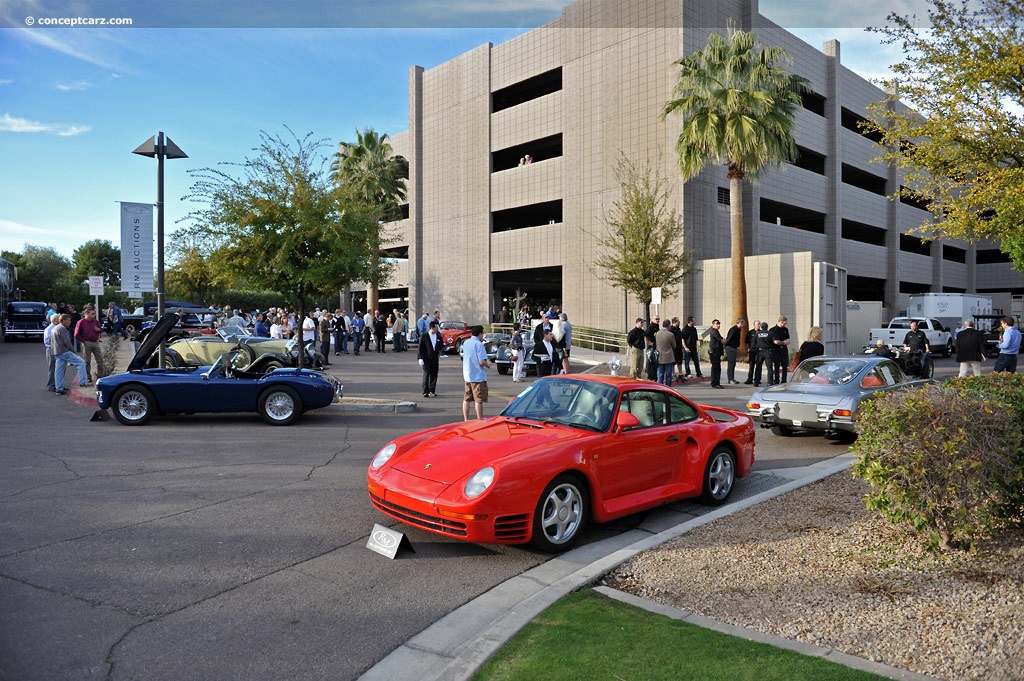
Coupe
Chassis #: WP0ZZZ95ZHS900113
View info and history
Auction entries : 1
The FIA (Fédération Internationale de l'Automobile) introduced Group B regulations for grand touring (GT) vehicles in 1982. Although these regulations were for vehicles used in sports car racing and rallying, Group B was commonly associated with the international rallying scene, where it fostered some of the most powerful and fastest rally cars ever built.Porsche introduced its new 'Gruppe B' contender at the 1983 Frankfurt Auto Show. Known internally as the Type 961, it was the German automaker's entry into the FIA Group B international rally championship arena, where the only rule was that there were no rules. The no-limits policy encouraged technology, exotic materials, and unbridled power for these rally specials, as long as a minimum of 200 examples were built for the road. When the FIA abruptly canceled Group B following a rash of serious accidents, some fatal, the race cars were permitted in regional championships providing they met the limit of 1600cc for four-wheel-drive or were homologated prior to 1984. With the cancellation, Porsche found itself in a dire financial situation as it needed to recover its huge investment in tooling and research. With no favorable option, the company's board of directors chose to press ahead, hoping their limited number of wealthy customers would be willing to purchase a 200 mph road car.The Group B international rallying class lasted from 1982 to 1986 and is considered as the golden era of rallying. The Porsche 959 was ready for homologation in 1987, a year after the cancellation of Group B. The Genesis of the Porsche 959
Helmut Bott was a gifted engineer and an effective manager. He served several roles at Porsche during his career, including chief test engineering and senior engineer. His expertise was applied to both road-going and track-based vehicles, as he understood their symbiotic relations and how the engineering improvements of one often benefit the other.Shortly after Peter Schutz became Managing Director of Porsche in 1981, Mr. Bott conveyed his idea for a state-of-the-art 911-based chassis for Group B rallying, ensuring a steady flow of improvements for its road-going products. Throughout the company's history, Porsche had enjoyed enormous success with its production-based race cars, even though they rarely developed such models as official factory entries. Instead, these cars were often championed by privateers with factory support. The advent of the Type 959 during the mid-1980s was one of the rare exceptions.
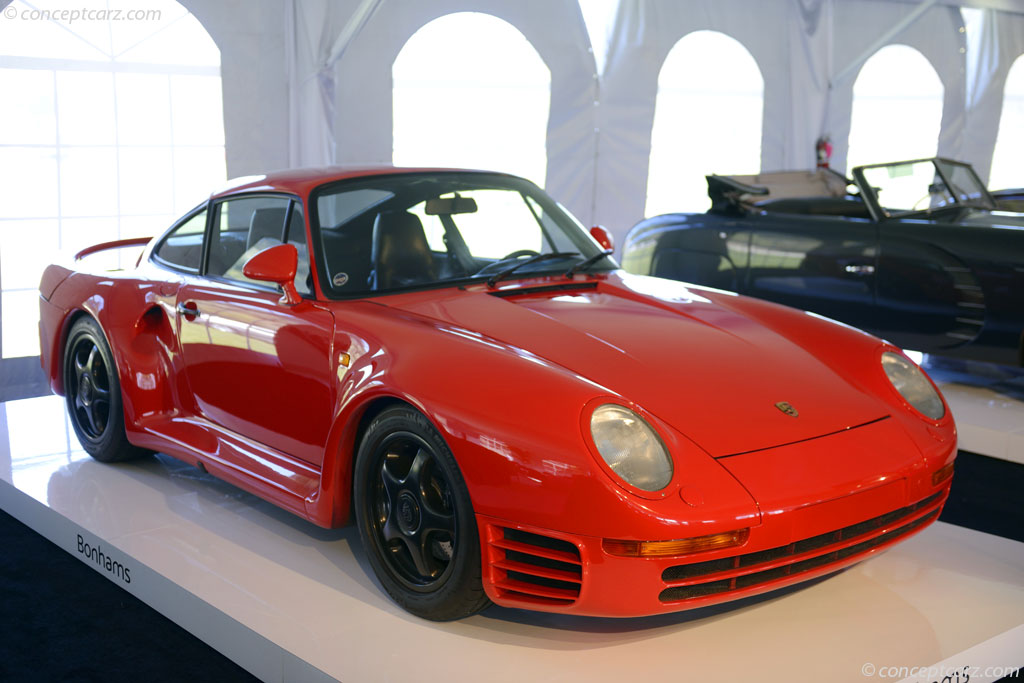
Coupe
Chassis #: WPOZZZ95ZHS900125
Engine #: 65H00117
View info and history
Auction entries : 1
The Porsche 959 rested on an 89.4-inch wheelbase with an overall length of 167.7 inches, a height of 50.4 inches, and a width of 72.4 inches. The center-section of the chassis was reinforced with longitudinal side members and an integral roll cage. The 17-inch diameter (8 inches wide in the front and nine inches in the rear), Denloc magnesium alloy wheels were hollow inside to form a sealed chamber contiguous with the tire. It was suspended via an independent suspension system with upper and lower A-arms, coil springs, dual shocks, and adjustable ride height and damping.
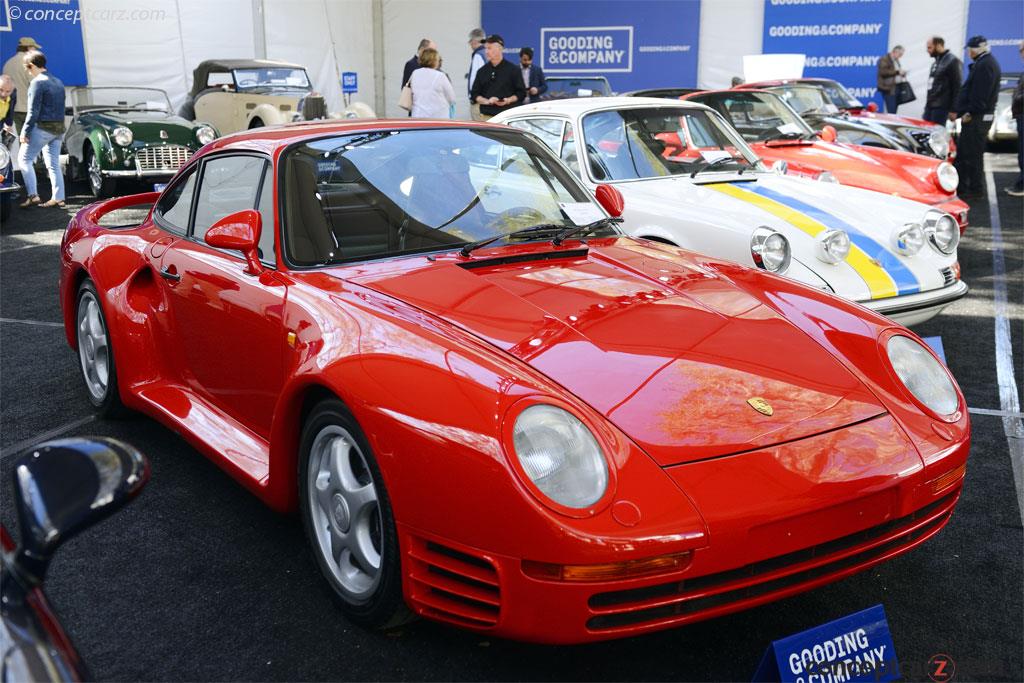
Coupe
Chassis #: WP0ZZZ95ZHS900110
View info and history
Auction entries : 1
The dual overhead camshaft flat-six engine had four valves per cylinder, a Bosch Motronic 2.1 fuel injection system, and displaced 173.9 cubic inches (2,849 cc). Group B regulations permitted engine capacities up to four liters, or a 1.4 equivalence for turbocharged motors. Thus, forced induction engines had to displace less than 2,857cc. A bore of 95mm and stroke of 67mm resulted in a 2,849cc size for the 959.The cylinders were air-cooled, but the cylinder heads themselves were water-cooled, similar to the company's 935 Le Mans racing engines. Sequential KKK twin-turbochargers provided smooth delivery of power across the engine's speed band, virtually eliminating the 'turbo lag' that was common to single-turbo engines of the period. Porsche first used turbocharging technology on the 917/10 Can-Am racing car in 1972, and three years later, it was adapted to the road-going 911, birthing the 911 Turbo of 1975. Engine cooling followed a similar story, first with its racing program after the thermal limited of the air-cooled flat-six had been reached. Water-cooled heads appeared on the Porsche 956 endurance racing prototype in 1982, with the 959 being the beneficiary of these successful experiments. The all-alloy Type 959/50 flat-6 engine had an 8.3:1 compression ratio, dry-sump lubrication, and produced approximately 444 horsepower at 6,500 RPM and 369 lb-ft of torque at 5,000 RPM. The pistons were forged alloy, each cylinder was lined with Nikasil carbide, and the connection rods were titanium.This engine remained virtually unchanged in specification for the road car program. The transaxle contained five forward speeds, plus a special, extremely low G gear for off-road use and the usual single reverse cog. This new six-speed manual had a twin-plate clutch.Body Material and Styling
The bodywork had a low drag coefficient rating of 0.31 and was designed to increase stability, as was the automatic ride-height adjustment system that became available on the road car. Vents in the front and rear wheel housings, and intake holes behind the doors, helped funnel air to the brakes. The extended nose helped improve aerodynamics and had headlights mounted under clear covers. The rear section was extended and entirely redesigned like the front, with a lift-up engine cover with an integrated 'basket handle' spoiler. Underneath the front lid was a 90-liter fuel tank.The body panels and chassis was constructed from aluminum and Aramid (Kevlar) composite; the body panels were made from Kevlar while the doors and front lid were from aluminum. The bumpers were polyurethane GRP composite, and the floorpan was a composite material that was lined with fire-resistant Nomex. It was a very robust and rigid body shell that helped the 959 achieve a low curb weight of less than 3,200 pounds in street trim.The Porsche 959 was produced at Karosserie Baur.Interior
The cockpit of the 959 was similar to other rear-engined Porsche models, with minor changes to the instrumentation and a redesigned forward section of the transmission tunnel. The sport seats were uniquely upholstered with the backs and bases done in white, silver and grey inserts. Most of the rear seats of the 959 matched the front seats.
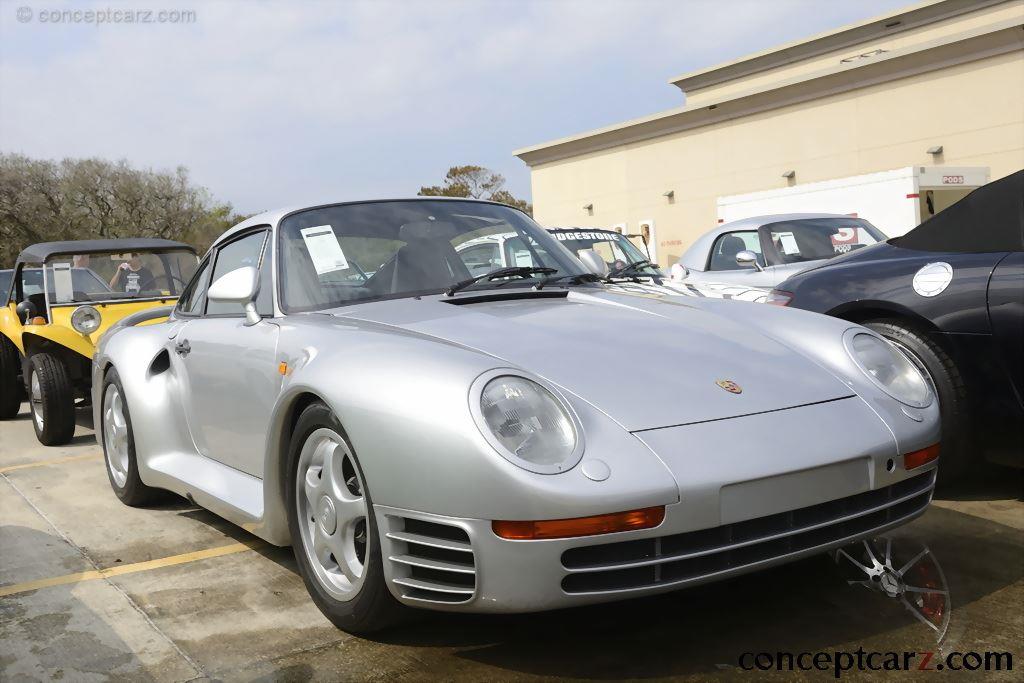
Coupe
Chassis #: WP0ZZZ95ZHS900051
Engine #: 65H00162
View info and history
Auction entries : 1
The Porsche 959 was offered in a limited range of exterior colors that included red, white, silver, black, garnet, and anthracite. A few VIP customers had their 959s painted in other shades. Additionally, the wheels could be colored silver, white, or body color. An alarm, leather-covered roll cage, and heater seats were also on the options list.Sport and Komfort
The Porsche 959 was offered in two levels of trim, 'Sport' and 'Komfort,' with the former being more tuned to the track while the latter received more creature comforts making it better suited to the road. Komfort examples received air conditioning, leather sports seats, and numerous power accessories. Performance
The Porsche 959 could sprint from zero-to-sixty mph in less than four seconds and had a top speed of 197 mph.Shifting Focus : From the Track to the Road
When the rapid and unexpected end of the FIA's Group B Rally Championship, Porsche was in a precarious bind. They had committed to building the minimum of 200 examples required for homologation, and it had invested a great deal of resources. Would the market support an exotic, high-priced, road-going supercar of this stature? The answer came quickly - yes, as every one of the 200 was instantly spoken for, even with a base price in excess of $225,000 (MSRP of 420,000 DM), which did not come close to the company's cost of production. It is estimated that the company lost 50% of its cost for each unit sold. Thus, the 959 has become known as 'Porsche's gift to its best customers.' Wealthy Porsche enthusiasts who did not make the exclusive clientele list often paid high premiums to take over the scarce contracts.
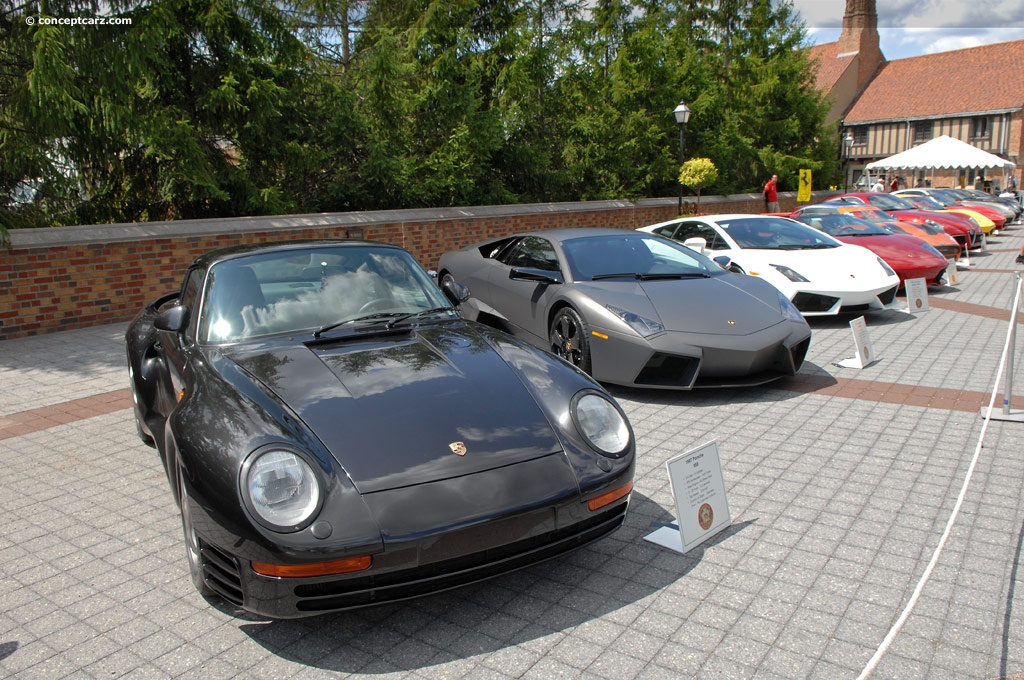
Coupe
The Porsche 959 could not be imported to the United States for street use since the company did not want to submit any of these valuable automobiles for the required crash-test. Since they did not have NHTSA and EPA approval, the example that Microsoft founder Bill Gates bought in 1988 remained in storage for thirteen years by the Customs Service. Thankfully, it was not destroyed, as is customary with forbidden automobiles, and when the 'Show or Display' law was enacted on August 13, 1999, the car was delivered to Gates. This new law allowed usage of the car limited to 2,500 annual road miles. With the 959 now being over 25 years old, they can be imported and registered in the U.S. without federal restrictions.Under the 'Show or Display' law, a certain few models were legally imported to the United States with annual mileage restrictions. Other examples were eventually significantly modified at great cost by their owners to comply with federal regulations. Competition
The Porsche 959 contested two of the most grueling and demanding arenas in international motorsports - the 24 Hours of Le Mans (as the 961) and the Paris-Dakar Rally.

Coupe
In 1984, three development 959 race cars contested the Paris-Dakar Rally, which, unlike the World Rally Championship, did not require a minimum number of cars built for homologation. Rene Metge finished 1st, Jacky Ickx in 6th, and a third car in 25th. A trio of 959s returned a year later, wearing the proposed 959 body but the engine of the 953 rally cars. All three cars failed to finish. In 1986, René Metge placed first, Jacky Ickx in 2nd, and a third 959 in 6th.Two cars competed in October 1985 at the Rallye des Pharaons with the car driven by Saeed Al-Hajri and John Spiller finishing in first. The other car caught fire.24 Hours of Le Mans
The racing variant of the 959, the Porsche 961, raced at the 24 Hours of Le Mans in 1986. Piloted by René Metge and Claude Ballot-Léna, it finished first in class and seventh overall. A year later, it was in 11th place when Dees Nierop mis-shifted from 6th into 2nd gear and crashed into the guard-place. The car briefly returned to the track but quickly pulled over between marshal stations due to fire. By the time it was extinguished, most of the rear end had been destroyed. The car was later repaired and put on display at the Porsche Museum.
by Daniel Vaughan | Jul 2023
Related Reading : Porsche Type 959 History
In 1981, the development of the 959 began. Helmut Bott, the head engineer at Porsche, wanted to create a sports car based on the 911 that would take their product to the next level in performance, technology, and design. He began by collaborating with Peter Schutz, the Managing Director at Porsche, about his ideas. The ideas proposed were to continue with the rear engine configuration, examine the....
Continue Reading >>
Continue Reading >>
Similar Automakers
1987 Porsche 959 Vehicle Profiles
Recent Vehicle Additions
Performance and Specification Comparison
Price Comparison
$19,905
$25,505 - $33,255
$38,505 - $76,505
$58,755 - $76,505
$58,901
$223,000
Type 959 Specification Comparison by Year
Year
Production
Wheelbase
Engine
Prices
Related Automotive News

Volkswagen Golf Alltrack And Sportwagen To End Production In 2019
Golf Alltrack to remain in production through December in Puebla
Upcoming SUVs and ID. family models to provide style and spaciousness in new ways
Herndon, VA — Volkswagen of America announced today that the critically-acclaimed Volkswagen...

FROM LE MANS TO GOODWOOD: FORD GT RACE CAR HEADS EXCITING FORD PERFORMANCE LINE-UP AT 2016 FESTIVAL OF SPEED
#66 Ford GT Le Mans race car tackles Goodwood Hillclimb driven by Marino Franchittiand Dirk Müller fresh from success at the 2016 Le Mans 24 Hours
Ford Performance rallycross driver and internet sensation Ken Block returns to the world-famous 1.16-...
MODEL YEAR 2015: NEW GOLF FAMILY, REDESIGNED JETTA, AND NEW TDI® CLEAN DIESEL ENGINE HEAD THE CHANGES
In a busy year, Volkswagen will also add a new Golf SportWagen, an all-new Golf R, a redesigned Touareg SUV, and the companys first U.S.-market EV, the e-Golf
All-new Golf is bigger, lighter, and more fuel-efficient than the previous model,...

NEW VOLKSWAGEN GOLF R MAKES ITS U.S. DEBUT AT THE 2014 NORTH AMERICAN INTERNATIONAL AUTO SHOW
Most powerful production Golf ever for the North American market
New car has an estimated 290 horsepower, but is more fuel efficient than previous Golf R
EA888 TSI® 2.0-liter engine propels DSG® equipped Golf R from 0 to 62 mph in 4.9 seconds
...

NEW VOLKSWAGEN GOLF R MAKES ITS U.S. DEBUT AT THE 2014 NORTH AMERICAN INTERNATIONAL AUTO SHOW
Most powerful production Golf ever for the North American market
New car has an estimated 290 horsepower, but is more fuel efficient than previous Golf R
EA888 TSI® 2.0-liter engine propels DSG® equipped Golf R from 0 to 62 mph in 4.9 seconds
Car...
